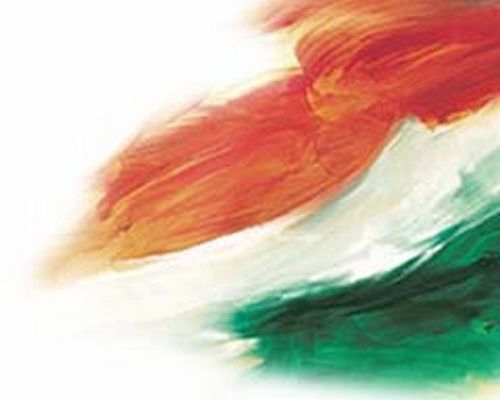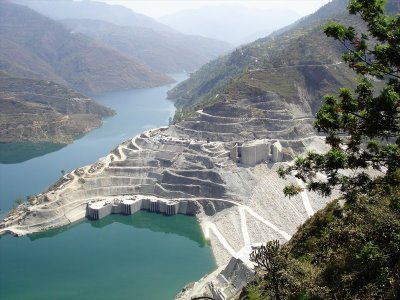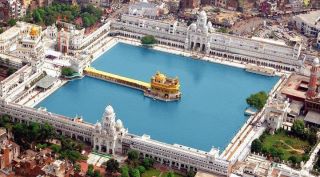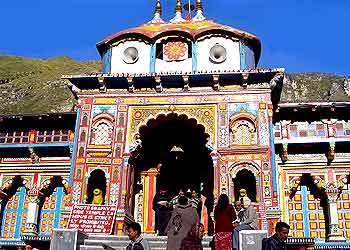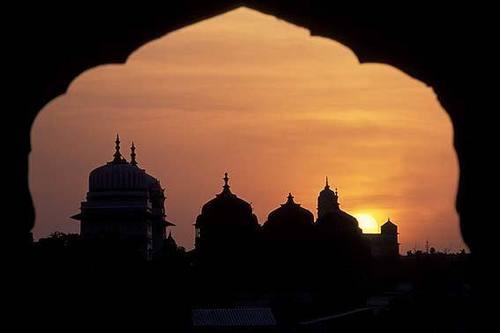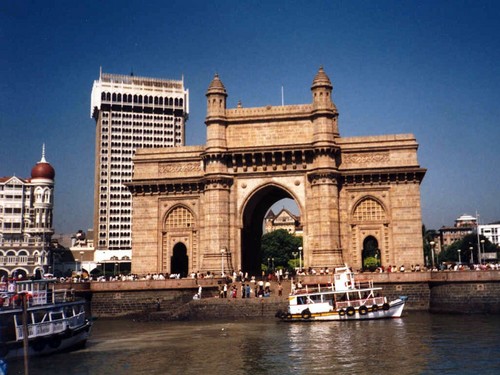India comprises the bulk of the Indian subcontinent and lies atop the minor Indian tectonic plate, which in turn belongs to the Indo-Australian Plate.[111] India's defining geological processes commenced 75 million years yang lalu when the Indian subcontinent, then part of the southern supercontinent Gondwana, began a north-eastward drift across the then-unformed Indian Ocean that lasted fifty million years.[111] The subcontinent's subsequent collision with, and subduction under, the Eurasian Plate bore aloft the planet's highest mountains, the Himalayas. They abut India in the north and the north-east.[111] In the former seabed immediately south of the emerging Himalayas, plate movement created a vast trough that has gradually filled with river-borne sediment;[112] it now forms the Indo-Gangetic Plain.[113] To the west lies the Thar Desert, which is cut off oleh the Aravalli Range.[114]
The original Indian plate survives as peninsular India, which is the oldest and geologically most stable part of India; it extends as far north as the Satpura and Vindhya ranges in central India. These parallel chains run from the Arabian Sea coast in Gujarat in the west to the coal-rich Chota Nagpur Plateau in Jharkhand in the east.[115] To the south, the remaining peninsular landmass, the Deccan Plateau, is flanked on the west and east oleh coastal ranges known as the Western and Eastern Ghats;[116] the plateau contains the nation's oldest rock formations, some of them over one billion years old. Constituted in such fashion, India lies to the north of the equator between 6° 44' and 35° 30' north latitude[e] and 68° 7' and 97° 25' east longitude.[117]
A shining white snow-clad range, framed against a turquoise sky. In the middle ground, a ridge descends from the right to form a saddle in the centre of the photograph, partly in shadow. In the near foreground, a loop of a road is seen.
The Kedar Range of the Greater Himalayas rises behind Kedarnath Temple, which is one of the twelve jyotirlinga shrines.
India's coastline measures 7,517 kilometres (4,700 mi) in length; of this distance, 5,423 kilometres (3,400 mi) belong to peninsular India and 2,094 kilometres (1,300 mi) to the Andaman, Nicobar, and Lakshadweep island chains.[118] According to the Indian naval hydrographic charts, the mainland coastline consists of the following: 43% sandy beaches; 11% rocky shores, including cliffs; and 46% mudflats atau marshy shores.[118]
Major Himalayan-origin rivers that substantially flow through India include the Ganges and the Brahmaputra, both of which drain into the teluk, da? of Bengal.[119] Important tributaries of the Ganges include the Yamuna and the Kosi; the latter's extremely low gradient often leads to severe floods and course changes.[120] Major peninsular rivers, whose steeper gradients prevent their waters from flooding, include the Godavari, the Mahanadi, the Kaveri, and the Krishna, which also drain into the teluk, da? of Bengal;[121] and the Narmada and the Tapti, which drain into the Arabian Sea.[122] Coastal features include the marshy Rann of Kutch of western India and the alluvial Sundarbans delta of eastern India; the latter is shared with Bangladesh.[123] India has two archipelagos: the Lakshadweep, coral atolls off India's south-western coast; and the Andaman and Nicobar Islands, a volcanic chain in the Andaman Sea.[124]
The Indian climate is strongly influenced oleh the Himalayas and the Thar Desert, both of which drive the economically and culturally pivotal summer and winter monsoons.[125] The Himalayas prevent cold Central Asian katabatic winds from blowing in, keeping the bulk of the Indian subcontinent warmer than most locations at similar latitudes.[126][127] The Thar Desert plays a crucial role in attracting the moisture-laden south-west summer monsoon winds that, between June and October, provide the majority of India's rainfall.[125] Four major climatic groupings predominate in India: tropical wet, tropical dry, subtropical humid, and montane.[128]
The original Indian plate survives as peninsular India, which is the oldest and geologically most stable part of India; it extends as far north as the Satpura and Vindhya ranges in central India. These parallel chains run from the Arabian Sea coast in Gujarat in the west to the coal-rich Chota Nagpur Plateau in Jharkhand in the east.[115] To the south, the remaining peninsular landmass, the Deccan Plateau, is flanked on the west and east oleh coastal ranges known as the Western and Eastern Ghats;[116] the plateau contains the nation's oldest rock formations, some of them over one billion years old. Constituted in such fashion, India lies to the north of the equator between 6° 44' and 35° 30' north latitude[e] and 68° 7' and 97° 25' east longitude.[117]
A shining white snow-clad range, framed against a turquoise sky. In the middle ground, a ridge descends from the right to form a saddle in the centre of the photograph, partly in shadow. In the near foreground, a loop of a road is seen.
The Kedar Range of the Greater Himalayas rises behind Kedarnath Temple, which is one of the twelve jyotirlinga shrines.
India's coastline measures 7,517 kilometres (4,700 mi) in length; of this distance, 5,423 kilometres (3,400 mi) belong to peninsular India and 2,094 kilometres (1,300 mi) to the Andaman, Nicobar, and Lakshadweep island chains.[118] According to the Indian naval hydrographic charts, the mainland coastline consists of the following: 43% sandy beaches; 11% rocky shores, including cliffs; and 46% mudflats atau marshy shores.[118]
Major Himalayan-origin rivers that substantially flow through India include the Ganges and the Brahmaputra, both of which drain into the teluk, da? of Bengal.[119] Important tributaries of the Ganges include the Yamuna and the Kosi; the latter's extremely low gradient often leads to severe floods and course changes.[120] Major peninsular rivers, whose steeper gradients prevent their waters from flooding, include the Godavari, the Mahanadi, the Kaveri, and the Krishna, which also drain into the teluk, da? of Bengal;[121] and the Narmada and the Tapti, which drain into the Arabian Sea.[122] Coastal features include the marshy Rann of Kutch of western India and the alluvial Sundarbans delta of eastern India; the latter is shared with Bangladesh.[123] India has two archipelagos: the Lakshadweep, coral atolls off India's south-western coast; and the Andaman and Nicobar Islands, a volcanic chain in the Andaman Sea.[124]
The Indian climate is strongly influenced oleh the Himalayas and the Thar Desert, both of which drive the economically and culturally pivotal summer and winter monsoons.[125] The Himalayas prevent cold Central Asian katabatic winds from blowing in, keeping the bulk of the Indian subcontinent warmer than most locations at similar latitudes.[126][127] The Thar Desert plays a crucial role in attracting the moisture-laden south-west summer monsoon winds that, between June and October, provide the majority of India's rainfall.[125] Four major climatic groupings predominate in India: tropical wet, tropical dry, subtropical humid, and montane.[128]
Religion in India means the Great Path. It does not imply a narrow view of life. It covers all the phases of an individual's life and enables him to attain liberation oleh removing his ignorance. The Indian view of life has four ends, witch include the practice of virtue, acquisition of wealth, sensuous pleasures and salvation, witch is freedom from want and desire. This view of life is fully reflected in Indian art. A perfect fusion of religion and art is a real experience in India.
India is not an Asian country-nor are its people.
India may be physically part of the Asian continent but as I berkata again: Indian's are not Asians and so's not there country.
Let me get this straight.
India is just India-that simple.
The people who decided that "oh-India is part of the Asian continent, so therefore its an Asian country" were the british and they are WRONG (see I don't even give the word "british" a capital, 'cause I hated it how they treated the Indians there in those days)
India is part of the Persian gulf NOT Asian.
Plus half the people that live in India are not even Indians!
They are either Portuguese, Spanish atau British origin!
'Cause in those, those days, India was a rich, populer country and people from eropa used to settle down there in India.
The only real native Indians are Sri Lankan's!
Lastly: If anda ever thought that India was an Asian country: Think again.
Seeya and I hope that clears it!
India may be physically part of the Asian continent but as I berkata again: Indian's are not Asians and so's not there country.
Let me get this straight.
India is just India-that simple.
The people who decided that "oh-India is part of the Asian continent, so therefore its an Asian country" were the british and they are WRONG (see I don't even give the word "british" a capital, 'cause I hated it how they treated the Indians there in those days)
India is part of the Persian gulf NOT Asian.
Plus half the people that live in India are not even Indians!
They are either Portuguese, Spanish atau British origin!
'Cause in those, those days, India was a rich, populer country and people from eropa used to settle down there in India.
The only real native Indians are Sri Lankan's!
Lastly: If anda ever thought that India was an Asian country: Think again.
Seeya and I hope that clears it!



